
Ranunculus is a large genus of about almost 1700 to more than 1800 species of flowering plants in the family Ranunculaceae. Members of the genus are known as buttercups, spearworts and water crowfoots.

Ranunculus repens, the creeping buttercup, is a flowering plant in the buttercup family Ranunculaceae, native to Europe, Asia and northwestern Africa. It is also called creeping crowfoot and sitfast.

Anemonoides nemorosa, the wood anemone, is an early-spring flowering plant in the buttercup family Ranunculaceae, native to Europe. Other common names include windflower, European thimbleweed, and smell fox, an allusion to the musky smell of the leaves. It is a perennial herbaceous plant growing 5–15 cm (2–6 in) tall.

Caltha palustris, known as marsh-marigold and kingcup, is a small to medium size perennial herbaceous plant of the buttercup family, native to marshes, fens, ditches and wet woodland in temperate regions of the Northern Hemisphere. It flowers between April and August, dependent on altitude and latitude, but occasional flowers may occur at other times.
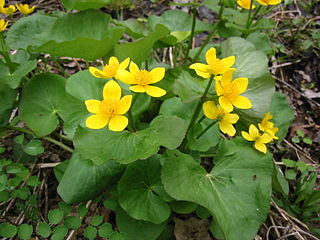
Caltha is a genus of rhizomatous perennial flowering plants in the family Ranunculaceae, to which ten species have been assigned. They occur in moist environments in temperate and cold regions of both the Northern and Southern Hemispheres. Their leaves are generally heart-shaped or kidney-shaped, or are characteristically diplophyllous. Flowers are star shaped and mostly yellow to white. True petals and nectaries are missing but the five or more sepals are distinctly colored. As usual in the buttercup family there is a circle of stamens around free carpels.

Ranunculus bulbosus, commonly known as bulbous buttercup or St. Anthony's turnip, is a perennial flowering plant in the buttercup family Ranunculaceae. It has bright yellow flowers, and deeply divided, three-lobed long-petioled basal leaves.

Geranium bicknellii is a species of geranium known by the common names Bicknell's cranesbill and northern cranesbill. It is native to much of the northern half of North America, where it can be found in a number of forest and woodland habitats. This is an annual or biennial herb which grows hairy stems up to about half a meter long. It may be erect or lie near the ground. Each leaf is several centimeters long and wide and is divided into several lobes, each of which may have smaller lobes or teeth. Flowers grow singly or in pairs and have pointed sepals and small lavender petals, each with a notch in the tip. The fruit has a rounded body with a long, straight style about 2 centimeters in length and tipped with a small beak.

Ranunculus eschscholtzii is a species of buttercup flower known by the common name Eschscholtz's buttercup.

Ranunculus recurvatus, the blisterwort or hooked crowfoot, is a plant species of the genus Ranunculus in the family Ranunculaceae native to eastern North America. It is an early-flowering plant of moist deciduous woods from central Quebec south to Florida.

Ranunculus pedatifidus is a species of buttercup known by the common names surefoot buttercup, northern buttercup, and birdfoot buttercup. It has a circumpolar distribution, occurring throughout the northern latitudes of the Northern Hemisphere. There are two varieties, var. pedatifidus occurring mostly in Asia and var. affinis mostly native to North America.
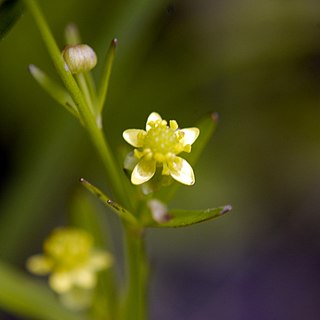
Ranunculus abortivus is a species of flowering plant in the buttercup family, Ranunculaceae. Its common names include littleleaf buttercup, small-flower crowfoot, small-flowered buttercup, and kidneyleaf buttercup. It is widespread across much of North America, found in all ten Canadian provinces as well as Yukon and the Northwest Territories, and most of the United States, except Hawaii, Oregon, California, and parts of the Southwest.
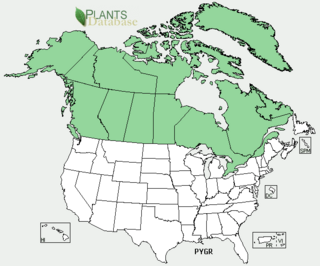
Pyrola grandiflora (pronunciation , commonly known as Arctic wintergreen or largeflowered wintergreen, is a hardy perennial evergreen subshrub in the family Ericaceae. It is widely distributed in the Northern Hemisphere from temperate to tundra-like climates.

Rubus flagellaris, the northern dewberry, also known as the common dewberry, is a North American species perennial subshrub species of dewberry, in the rose family. This dewberry is distributed across much of Canada, Mexico, and the United States. It grows in diverse habitats ranging from drier savannas to temperate deciduous forests.
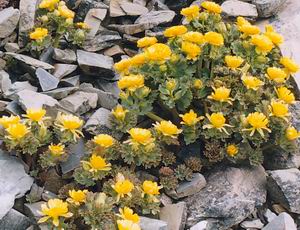
Ranunculus acraeus is a species of flowering plant in the buttercup family, Ranunculaceae, found in New Zealand. This rare and native species strictly grows on an alpine habitat, hence the name acraeus, meaning “on high”. The plant grows about 50 cm (20 in) in width, and is covered in beautiful, bright yellow flowers. It may be mistaken for R. piliferus but research has shown R. acraeus to be its own distinctive species.

Ranunculus acaulis, in Australia and New Zealand called dune buttercup, sand buttercup or shore buttercup, is a yellow-flowered, small, fleshy herb, that grows in mats in damp places mostly near the sea. It occurs naturally in Australia, New Zealand, Chile and the Falklands. It flowers between August and April and sets seed from September till July.

Ranunculus hispidus is a species of perennial flowering plant in the buttercup family, Ranunculaceae. It is commonly known as bristly buttercup or hispid buttercup. It is a small plant native to central and eastern North America that grows to a height up to 30 cm (1 ft) and has 5-petaled yellow flowers.

Ranunculus allegheniensis is a species of flowering plant in the buttercup family, Ranunculaceae. Its common names include Allegheny Mountain buttercup and Allegheny crowfoot.

Ranunculus arcticus, the birdfoot buttercup, is a species of buttercup in the family Ranunculaceae. It has a circumpolar distribution in Northern Europe, Northern Asia and North America.

Ranunculus tripartitus, three-lobed crowfoot, is a species of flowering plant in the family Ranunculaceae, which grows in pools and muddy hollows in coastal parts of Europe, North Africa and West Asia. It is rare and endangered throughout its range, and is considered to be an indicator of favourable environmental conditions.
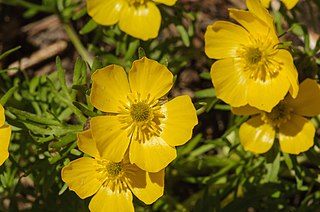
Ranunculus adoneus, the alpine buttercup or snow buttercup, is a species of flowering plant. It is an alpine buttercup from the family Ranunculaceae. This species is mainly found in the Rocky Mountains in Colorado and Wyoming but can also be found in Idaho, northern Utah and eastern Nevada. Its typical habitat is short grass meadows near the edge of melting snow.



















